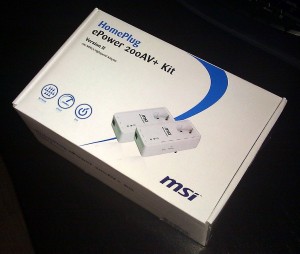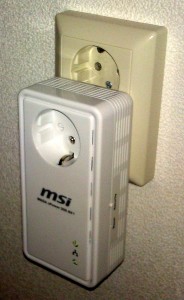Don’t buy HomePlug / Powerline ethernet adapters
Contents
(Post summary: The real-world throughput of current generation Homeplug AV 200 Mbit/s powerline ethernet adapters in a modern house is woefully inadequate. Even wireless is much to be preferred, and can be had for cheaper. Read below for why.)
Based on the superb price / performance ratio of the MSI ePower 200AV II kit as extolled by this comparative review (32 powerline adapters were tested), and especially the fact that in the test setup these adapters managed to attain 32 Mbit/s even in the bad case scenario (two different circuits, 100 metres of cable separating the two adapters), I purchased the MSI ePower 200AV+ II kit to replace a wireless link I currently have in my house between the second and third floors. Based on iperf measurements, the wireless link currently manages around 22Mbit/s of throughput. Because the two power sockets I was planning to use are on the same circuit, I thought that I could improve on this existing connection with the two powerline adapters. Little did I know…

After taking delivery of the new kit, I started testing with both adapters in the same room. One thing that can be said for this hardware, is that it’s really plug and play. One adapter in wall-socket and connected to first floor ethernet hub, second adapter in wall-socket and connected to my laptop, and my laptop was online. No mess no fuss.
The first nasty surprise appeared as I installed and started up up the software that came in the box (version 5.0). It claimed not to find any homeplug adapters on the network, although the laptop I was running it on was directly connected to one of the PLCs. So I downloaded version 6.0 of the software, only available in German, from MSI’s website and that did manage to see both adapters. At least now I was able to configure both the PLCs (in German…) and set the network name to something private for security’s sake.
After moving one of the adapters to my study on the third floor and connecting it to a Linux server there, I could start running iperf on the server and my laptop on the second floor for testing. The two PLC adapters were now in the same-circuit sockets I was intending to use. Below is the output of three runs of iperf:
C:\Users\cpbotha\Downloads>iperf -c 192.168.1.126 ------------------------------------------------------------ Client connecting to 192.168.1.126, TCP port 5001 TCP window size: 8.00 KByte (default) ------------------------------------------------------------ [148] local 192.168.1.38 port 49921 connected with 192.168.1.126 port 5001 [ ID] Interval Transfer Bandwidth [148] 0.0-10.0 sec 10.7 MBytes 8.95 Mbits/sec C:\Users\cpbotha\Downloads>iperf -c 192.168.1.126 ------------------------------------------------------------ Client connecting to 192.168.1.126, TCP port 5001 TCP window size: 8.00 KByte (default) ------------------------------------------------------------ [148] local 192.168.1.38 port 49987 connected with 192.168.1.126 port 5001 [ ID] Interval Transfer Bandwidth [148] 0.0-10.0 sec 11.2 MBytes 9.41 Mbits/sec C:\Users\cpbotha\Downloads>iperf -c 192.168.1.126 ------------------------------------------------------------ Client connecting to 192.168.1.126, TCP port 5001 TCP window size: 8.00 KByte (default) ------------------------------------------------------------ [148] local 192.168.1.38 port 49988 connected with 192.168.1.126 port 5001 [ ID] Interval Transfer Bandwidth [148] 0.0-10.0 sec 10.4 MBytes 8.70 Mbits/sec
Yes ladies and gentlemen, that’s an absolutely miserable 9 Mbit/s (think 1 Mbyte/s…) between two MSI ePower 200AV+ II adapters on the same circuit, on different floors in a house that was built 5 years ago. For your reference, my wireless link (two Sitecom 300N X2 access points in Wireless Distribution Mode) easily manages 22 Mbit/s effective throughput right through a reinforced concrete floor.
MSI’s own utility claimed the following (I’ve cut out things that you don’t need to see):
Rate 18/39 Vendor Atheros Firmware INT6400-MAC-4-0-4011-00-3430-20090501-FINAL-C Übertragungsrate hoch 174.00 Übertragungsrate niedrig 15.00
… with its reported link speed varying between 17 and 35 Mbit/s.
I tried the third floor PLC adapter on various different sockets, the results were similarly depressing.
As if the miserable throughput was not reason enough to avoid powerline adapters, note the following mechanical issue:

As you can see in the caption, although the PLC has a socket of its own, it covers the neighbouring socket in a double-socket setup to such an extent that you can only fit a really thin plug in the neighbouring socket.
To conclude: Homeplugs perform really well in a test environment, even when different circuits are introduced and metres of extra cable are inserted. However, what the tests often fail to take into account, is the fact that people actually make use of other electrical devices besides homeplugs (!!) and that these all introduce noise into the home grid that apparently severely affect powerline ethernet performance. Perhaps in your house things work out differently, but my advice would be to steer clear of powerline adapters (unless you can borrow a pair to test with), opting of course for ethernet cables whenever this is possible and for wireless otherwise.
